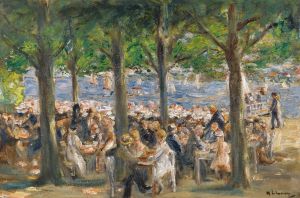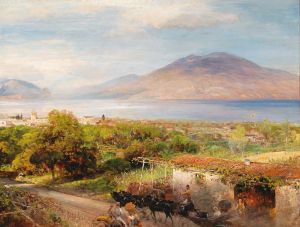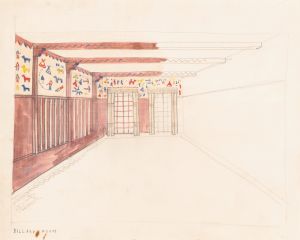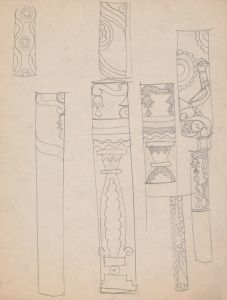
Designs for roadhouse or terrace restaurant. Perspective elevation showing terrace
A hand-painted replica of Winold Reiss’s masterpiece Designs for roadhouse or terrace restaurant. Perspective elevation showing terrace, meticulously crafted by professional artists to capture the true essence of the original. Each piece is created with museum-quality canvas and rare mineral pigments, carefully painted by experienced artists with delicate brushstrokes and rich, layered colors to perfectly recreate the texture of the original artwork. Unlike machine-printed reproductions, this hand-painted version brings the painting to life, infused with the artist’s emotions and skill in every stroke. Whether for personal collection or home decoration, it instantly elevates the artistic atmosphere of any space.
Winold Reiss (1886-1953) was a German-American artist known for his diverse body of work, which included portraits, murals, and interior designs. One of his notable works is "Designs for roadhouse or terrace restaurant. Perspective elevation showing terrace." This piece exemplifies Reiss's skill in architectural rendering and his ability to blend artistic creativity with functional design.
Reiss was born in Karlsruhe, Germany, and studied at the Royal Academy of Fine Arts in Munich. He immigrated to the United States in 1913, where he quickly established himself as a prominent artist and designer. His work was heavily influenced by his European training, yet he adapted his style to the American context, contributing significantly to the visual culture of the early 20th century.
The "Designs for roadhouse or terrace restaurant" is a detailed perspective elevation that showcases Reiss's architectural vision. The drawing illustrates a terrace restaurant, a popular social venue during the early 20th century, designed to provide an inviting and aesthetically pleasing environment for patrons. The perspective elevation technique used by Reiss allows viewers to understand the spatial relationships and the overall layout of the design, highlighting his meticulous attention to detail.
Reiss's design features a terrace, which is an elevated, open-air platform that extends from the main structure. This element is crucial in creating a seamless transition between indoor and outdoor spaces, offering diners a unique experience of enjoying their meals in a semi-outdoor setting. The terrace is likely adorned with decorative elements, such as railings, planters, and possibly awnings or umbrellas, which would provide both functionality and visual appeal.
The architectural style of the design reflects the trends of the time, possibly incorporating elements of Art Deco or other contemporary movements. Reiss was known for his ability to integrate modernist aesthetics with traditional motifs, creating spaces that were both innovative and timeless. His use of bold lines, geometric forms, and vibrant colors would have contributed to the dynamic and inviting atmosphere of the terrace restaurant.
Reiss's work extended beyond architectural designs; he was also renowned for his portraits of Native Americans and African Americans, which were celebrated for their respectful and dignified representation of these communities. His contributions to the Harlem Renaissance, through his portraits and collaborations with African American intellectuals and artists, further cemented his legacy as a culturally significant figure.
In summary, Winold Reiss's "Designs for roadhouse or terrace restaurant. Perspective elevation showing terrace" is a testament to his architectural prowess and artistic versatility. The design not only serves as a functional blueprint for a social venue but also as an example of Reiss's ability to blend aesthetic beauty with practical considerations. His work continues to be appreciated for its historical and cultural significance, reflecting the rich tapestry of early 20th-century American art and design.







![Designs for Indian Room, Chic-n-Coop Restaurant, Montreal, Canada.] [Placemat design with chicken character wearing crown](/imgs/249244/s/winold-reiss-designs-for-indian-room-chicncoop-restaurant-montreal-canada-placemat-design-with-chicken-character-wearing-crown-67b965b8.jpg)
![Graphic design for Photo Engravers Convention, Chicago.] [Poster featuring cartoon-like storks](/imgs/249252/s/winold-reiss-graphic-design-for-photo-engravers-convention-chicago-poster-featuring-cartoonlike-storks-9f0255ed.jpg)
![Graphic designs for Longchamps Restaurants.] [Cocktail card](/imgs/249257/s/winold-reiss-graphic-designs-for-longchamps-restaurants-cocktail-card-a188d857.jpg)


![Designs for the Puck Theater , New York, NY.] [Exterior perspective study](/imgs/249327/s/winold-reiss-designs-for-the-puck-theater-new-york-ny-exterior-perspective-study-df16fd5a.jpg)
![Drawings for proposed decorations of Mike Lyman’s Restaurant, 424 W. Sixth St., Los Angeles, CA.] [Drawing #7, playroom elevation L and bar elevation M](/imgs/249338/s/winold-reiss-drawings-for-proposed-decorations-of-mike-lymans-restaurant-424-w-sixth-st-los-angeles-ca-drawing-7-playroom-elevation-l-and-bar-elevation-m-f9ee50d2.jpg)
![Design proposals for Puck Theater, New York, NY.] [Interior perspective study.](/imgs/249414/s/winold-reiss-design-proposals-for-puck-theater-new-york-ny-interior-perspective-study-ba0eb061.jpg)
![Designs for restaurant and bar interiors with curving bars and stairways.] [Sketches for bars and restaurants](/imgs/249417/s/winold-reiss-designs-for-restaurant-and-bar-interiors-with-curving-bars-and-stairways-sketches-for-bars-and-restaurants-195836c8.jpg)
![Graphic design of nude female.] [Cubist composition drawing](/imgs/249427/s/winold-reiss-graphic-design-of-nude-female-cubist-composition-drawing-b6f17b02.jpg)
![Miscellaneous small sketches for inlaid table tops.] [Design with blue and orange floral motif](/imgs/249431/s/winold-reiss-miscellaneous-small-sketches-for-inlaid-table-tops-design-with-blue-and-orange-floral-motif-4e4a4b57.jpg)
